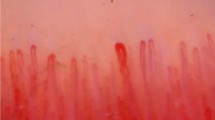Abstract
No guidelines for the application of qualitative and quantitative analysis of the capillaroscopic examination in the rheumatologic practice exist. The aims of the study were to compare qualitative and quantitative analysis of key capillaroscopic parameters in patients with common rheumatic diseases and to assess the reproducibility of the qualitative evaluation of the capillaroscopic parameters, performed by two different investigators. Two hundred capillaroscopic images from 93 patients with different rheumatic diseases were analysed quantitatively and qualitatively by two different investigators. The distribution of the images according to the diagnosis and the microvascular abnormalities was as follows—group 1: 73 images from systemic sclerosis patients (“scleroderma” type pattern), group 2: 10 images from dermatomyositis (“scleroderma-like” pattern), group 3: 25 images from undifferentiated connective tissue disease and different forms of overlap (24 “scleroderma-like”), group 4: 26 images from systemic lupus erythematosus patients, group 5: 46 images from rheumatoid arthritis and group 6: 20 images from primary Raynaud’s phenomenon patients. All the images were mixed and blindly presented to both investigators. For comparison of the quantitative and qualitative method, investigator 1 assessed presence of dilated, giant capillaries and avascular areas quantitatively by the available software programme and his estimates were compared with the results of investigator 2, who assessed the parameters qualitatively. In addition, the capillaroscopic images were evaluated qualitatively by the investigator 1 and 2 for presence of dilated, giant capillaries, avascular areas and haemorrhages. The comparison of the quantitative and qualitative assessment of the two investigators demonstrated statistically significant difference between the two methods for the detection of dilated and giant capillaries (P < 0.05) but no significant difference regarding the detection of avascular areas (P > 0.05). As we further analysed the results for the capillaroscopic images, demonstrating a “scleroderma” and a “scleroderma-like” pattern (170/200), analogous results were found for the evaluated parameters. Among the 20 capillaroscopic images from patients with primary RP, the estimates for the absence of giant capillaries and avascular areas were equal in 100% (P > 0.05). Comparing the qualitative assessment of the two investigators, a statistically significant difference between estimates of the two investigators was found for the presence of dilated capillaries (P < 0.05), while for giant capillaries, avascular areas and haemorrhages the difference was not statistically significant (P > 0.05). The results of the study have shown that qualitative assessment of capillaroscopic parameters in patients with rheumatic diseases is an adequate method for the everyday rheumatologic practice, especially in cases with primary RP for exclusion presence of microangiopathy. No significant difference between qualitative and quantitative methods of assessment was found for the detection of avascular areas. However, the quantitative analysis is more precise especially for the detection of capillary dilation. A good reproducibility of the qualitative evaluation, performed by two different investigators was also found.
Similar content being viewed by others
References
Bergman R, Sharony L, Schapira D, Nahir MA, Balbir-Gurman A (2003) The handheld dermatoscope as a nail-fold capillaroscopic instrument. Arch Dermatol 139:1027–1030
Bollinger A, Fagrell B (1990) Clinical capillaroscopy—a guide to its use in clinical research and practice. Hogrefe & Huber Publishers, Toronto, pp 1–123
Bredemeier M, Xavier RM, Capobianco KG, Restelli VG, Rohde LE, Pinotti AF et al (2004) Nailfold capillary microscopy can suggest pulmonary disease activity in systemic sclerosis. J Rheumatol 31:286–294
Cutolo M, Pizzorni C, Sulli A (2005) Capillaroscopy. Best Pract Res Clin Rheumatol 19(3):437–452
Cutolo M, Sulli A, Secchi ME, Olivieri M, Pizzorni C (2007) The contribution of capillaroscopy to the differential diagnosis of connective autoimmune diseases. Best Pract Res Clin Rheumatol 21(6):1093–1108
Dolezalova P, Young SP, Bacon PA, Southwood TR (2003) Nailfold capillary microscopy in healthy children and in childhood rheumatic diseases: a prospective single blind observational study. Ann Rheum Dis 62(5):444–449
Kabasakal Y, Elvins DM, Ring EF, McHugh NJ (1996) Quantitative nailfold capillaroscopy findings in a population with connective tissue disease and in normal healthy controls. Ann Rheum Dis 55:507–512
Lee P, Leung FY, Alderdice C, Armstrong SK (1983) Nailfold capillary microscopy in the connective tissue diseases: a semiquantitative assessment. J Rheumatol 10(6):930–938
Lefford F, Edwards JCW (1986) Nailfold capillary microscopy in connective tissue disease: a quantitative morphological analysis. Ann Rheum Dis 45:741–749
Maricq HR, Le Roy EC, D’Angelo WA, Medsger TA Jr, Rodnan GP, Sharp GC, Wolfe JF (1980) Diagnostic potential of in vivo capillary microscopy in scleroderma and related disorders. Arthritis Rheum 23(2):183–189
Maricq HR, Harper FE, Khan MM, Tan EM, LeRoy EC (1983) Microvascular abnormalities as possible predictors of disease subsets in Raynaud phenomenon and early connective tissue disease. Clin Exp Rheumatol 1(3):195–205
Maricq HR (1986) Comparison of quantitative and semiquantitative estimates of nailfold capillary abnormalities in scleroderma spectrum disorders. Microvasc Res 32(2):271–276
Redisch W (1970) Capillaroscopic observations in rheumatic diseases. Ann Reum Dis 29:244–253
Ohtsuka T (1999) Quantitative analysis of nailfold capillary abnormalities in patients with connective tissue diseases. Int J Dermatol 38(10):757–764
Schmidt JA, Caspary L, von Bierbrauer A, Ehrly AM, Jünger M, Jung F, Lawall H (1997) Standardisierung der Nagelfalz-Kapillarmikroskopie in der Routinediagnostik. Vasa 25:5–10
Conflict of interest
None.
Author information
Authors and Affiliations
Corresponding author
Rights and permissions
About this article
Cite this article
Lambova, S.N., Hermann, W. & Müller-Ladner, U. Comparison of qualitative and quantitative analysis of capillaroscopic findings in patients with rheumatic diseases. Rheumatol Int 32, 3729–3735 (2012). https://doi.org/10.1007/s00296-011-2222-2
Received:
Accepted:
Published:
Issue Date:
DOI: https://doi.org/10.1007/s00296-011-2222-2




